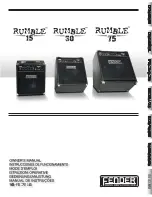
Quickstart Guide : Installing Pyramix Virtual Studio Hardware
Page 11
With most of the current generation motherboards this means either the mains switch on the power supply or the
power outlet switch. Where no switch is provided, either on the PC or the supply socket, then the PC should be
unplugged.
Always observe proper static precautions when handling any PC boards! Use a static strap, and/or be sure to firmly
ground yourself to the computer power supply, chassis or if the PC is unplugged, to a known good earth before
handling and installing the
Mykerinos
board.
Some PCs have batteries, cables, jumpers, etc. which could prevent proper board seating in one or more slots.
Make certain the board is firmly and fully seated before switching on.
Multi-board installation
Multiple boards must be installed in adjacent slots. To enable multi-board operation, all Mykerinos cards in the PC
have to be connected together using a special HDTDM ribbon cable. This cable has to be plugged into the multi-
pin connectors located on the top edge of the I/O daughter cards. Please contact your Merging Technologies
dealer for information on how to order this HDTDM ribbon cable.
HDTDM/XDTDM
The HDTDM board linking cable has the following functions in a multiple Mykerinos board installation:
a) synchronization (to 1/512th of an audio sample accuracy) This enables Pyramix to "see" a single system com-
prised of a large pool of DSP power and I/O resources spread over separate cards.
b) transfers all audio signals (Live Inputs, Internal Send/Return Busses, Mix busses, Aux busses, Live Outputs, etc.
between all the Mykerinos I/O daughter-cards which comprise the multi-board system.
Pyramix Virtual Studio Board I/O
Audio I/O Options
Mykerinos
is a modular board which can have any one of several optional audio I/O daughter cards attached.
When ordering Pyramix
Virtual
Studio
from Merging
Technologies or one of its distributors, be sure to specify the
daughter card appropriate to your specific needs. (
Please see Appendix II I/O Daughter-card Options on
page 78
)
On-board Analog Audio I/O
Regardless of which I/O daughter card is chosen, you can simultaneously use the 3.5mm stereo mini-phone jack
on the Mykerinos board as an unbalanced, analog stereo audio monitor output for all projects up to 384 kHz, with
levels programmable from within the Pyramix software. Sources at sample rates higher than 96 kHz are automati-
cally Sample Rate Converted to 96 kHz, 24 bit. This stereo mini-jack connection may be connected to headphones
or to a line level audio monitor input.
External Audio D/A-A/D Converter Boxes
Most of the I/O options for the Mykerinos board are digital. Pyramix will often be used with external audio D/A (for
playback) and A/D (for recording) converters. Many such converters are available from Merging Technologies as
options: for example, the
Merging
Technologies
Dua
II
and
Sphynx 2
. Contact your local Merging Technologies
Sales representative for more information.
Capabilities of third party A/D - D/A converter boxes are widely variable. Please check with the manufacturer to
ascertain which sample rates, word lengths and number of I/O channels are supported. You will need this informa-
tion later to appropriately configure the Pyramix software.
Time Code and Video Sync Option
The
Pyramix Synchronization
option provides SMPTE / EBU LTC and VITC time code in/out, video sync in/out and
word clock sync. A multi-pin circular mini-DIN connector, on the back plate of the Mykerinos board carries all the
system synchronization, time code and video sync signals. An optional break-out cable is provided for connec-
tions to time code, sync and video I/O. The Synchronization option allows Pyramix to be configured as a master or
slave lock to external time code, video or word clock. It also enables
VITC
and/or a visible time code burn-in win-
dow (
BITC
) to be added to video output/throughput.












































